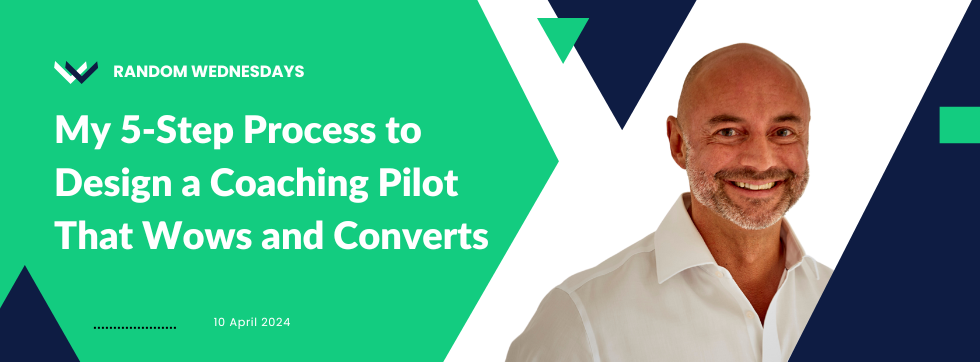Launching a coaching program is terrifying and exhilarating.
You have a powerful concept you believe can transform lives.
But how do you test it?
How can you ensure it lands with your target audience?
The answer is to create a program pilot.
A well-designed pilot allows you to:
- Gain valuable feedback
- Validate your coaching methodology
- Fine-tune your approach before a full-scale launch.
It’s a critical step to set your coaching program up for long-term success.
Here’s my 5 step process to help you create your pilot that wows and converts.
One that engages, impacts, and leaves your clients wanting more.
Let’s jump in.
Step1: Crystallise your concept
Before diving into the pilot design, you want to get crystal clear on your concept:
- What specific problem does your program aim to solve?
- Who is your target audience and what are their key pain points?
- What transformation do you want to help clients achieve?
- What is your unique coaching methodology or approach?
Take time to clearly articulate the core elements of your coaching program.
This forms the foundation upon which you’ll build your pilot.
Step 2: Choose your pilot structure
There are a few different structures to consider for your pilot:
1. Concept pilot
You dive right in. Introduce your coaching methodology, tools, and philosophies as if they are established and pre-existing.
You immediately start coaching your pilot clients using your signature approach.
2. Premise pilot
You start at the very beginning, as if you and your clients have never interacted before.
You introduce yourself. Explain your coaching style and process, and set expectations for the coaching journey.
The focus is on setting the stage.
3. Hybrid pilot
This is a combination of the concept and premise approaches.
Core parts of your coaching methodology are assumed to be established, but you use the pilot to introduce and test out a new technique, tool or process.
Consider which pilot structure best showcases your coaching strengths and fits the needs of your ideal clients.
Step 3: Map out your pilot flow
To create an engaging pilot experience, break your coaching process into a series of thoughtful segments.
This creates a roadmap for your clients.
Consider questions like:
- What is the natural beginning, middle, and end of your pilot?
- What key topics or phases will you guide clients through?
- How much time will you allocate to each segment?
For each segment, define:
- The core focus,
- Key learning points
- The specific coaching tools or exercises you will use.
The clearer your roadmap, the more confidence and trust your clients will have in the process.
Step 4: Seek out early feedback
Once you’ve mapped out your pilot, it’s time to pressure test it.
Identify a few key people who can provide informed, constructive feedback.
This could include:
- Past clients who know your work
- Potential clients who’ve expressed interest in your work
- Trusted colleagues who understand your target audience
Share your pilot outline and get their input:
Does the flow make sense and build logically?
- What elements are most compelling?
- What feels confusing or underdeveloped?
- How can you amp up the value and impact for clients?
Really listen to the feedback. Be open to making tweaks to enhance the power of your pilot.
Early input can help you avoid pitfalls and uncover opportunities to make your pilot even more compelling.
Step 5: Deliver a WOW pilot experience
As you execute your pilot, bring your full passion and expertise to the table.
Your energy and commitment will set the tone for the entire experience.
A few key things to keep in mind:
- Anchor the pilot in your unique coaching superpowers.
- Showcase what makes you an extraordinary coach.
- Create “wow” moments.
If you have a particularly impactful exercise or tool, consider moving it earlier in the process so pilot clients can experience that power right away.
Make each interaction memorable.
Pilot clients should walk away from every touchpoint feeling energised and inspired.
Eager to put your coaching insights into action.
Don’t forget to gather feedback throughout the process.
Ask clients:
- What’s working?
- What are they struggling with?
- What they’d like to see more of?
Then adapt accordingly.
Conclusion
Your coaching pilot is your opportunity to go above and beyond.
Demonstrating the immense value and transformation your coaching program provides.
Leave it all on the field.
Your next steps
Now it’s time to put these insights into action.
- Block out time this week to start mapping out your signature coaching program and pilot.
- Get crystal clear on your coaching concept, decide on your pilot structure, and outline that engaging client flow.
- Start sharing your pilot with trusted advisors to get early feedback.
- Then refine your approach and get ready to wow your first pilot clients.
Remember. A well-executed pilot is the springboard to a thriving, impactful coaching program.
Feel free to adapt this process to fit your unique coaching strengths and audience.
The key is to be intentional, get input early, and deliver an extraordinary experience.
You’ve got this!


